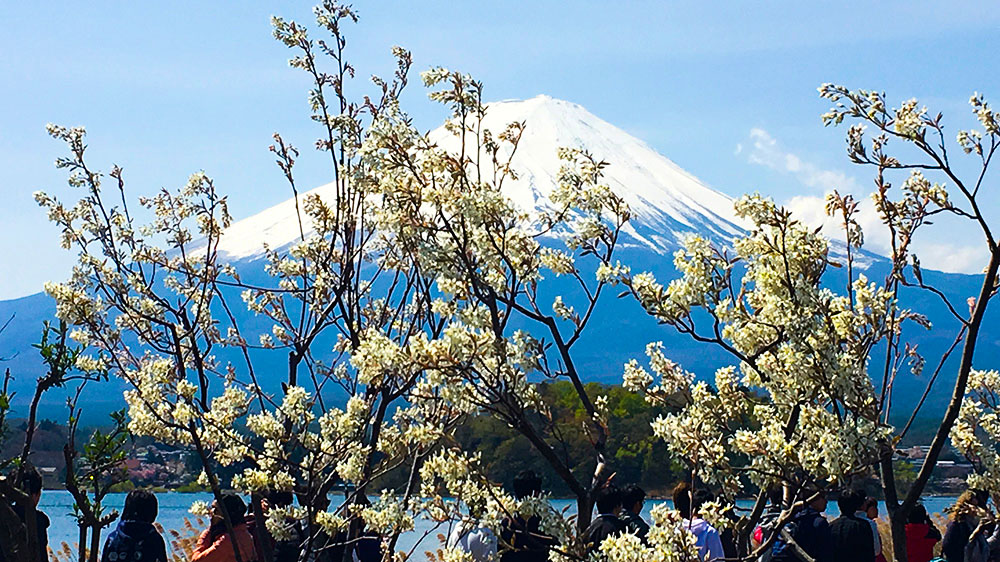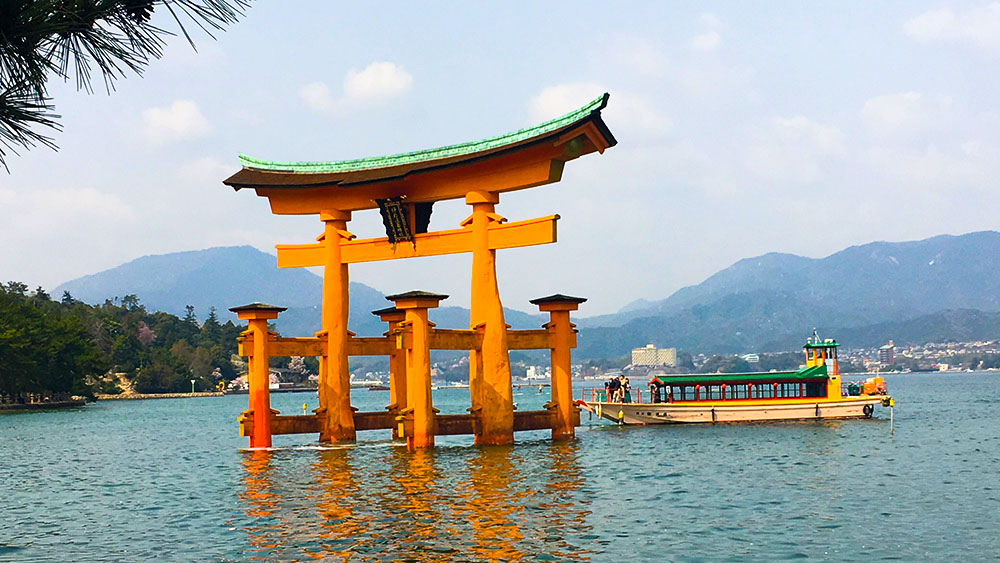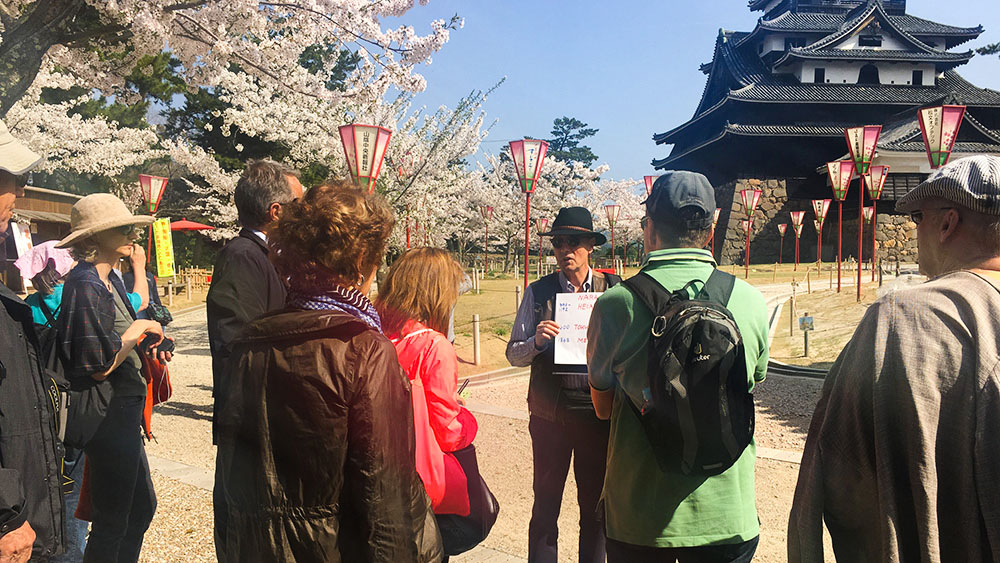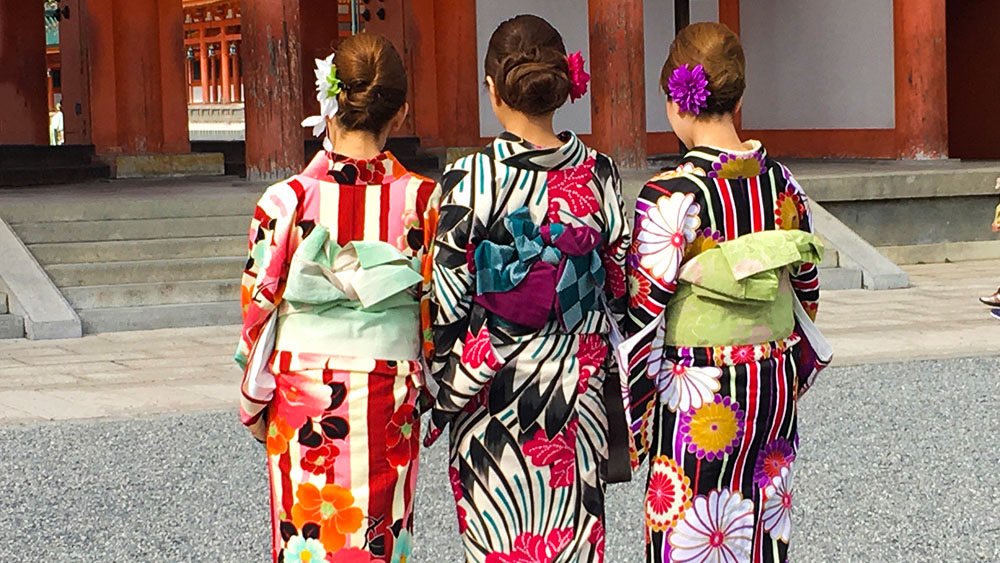Navigation auf uzh.ch
Navigation auf uzh.ch

In April the cherry blossoms bathe Japan in a haze of pink, and the dappled sunlight has an orange hue. This warm gentle palette of colors embraces us on our arrival in Osaka after an 11-hour flight. Accompanying the Alumni travel group is Bruno Rhyner, our guide for the next 17 days. The Jungian psychotherapist is a well-versed Japan aficionado. Our second guide, Yunko-San, is Japanese and meets us in Osaka. She turns out to be an organizational marvel and meticulously ensures that our trip runs without a single hitch.
We don’t linger in Osaka: We have a full itinerary to keep to, with 11 stops, so we catch a shinkansen – the famous white high-speed train – straight to the first stop on our tour, Hiroshima. The train is – as expected – bang on time, and draws up precisely in line with the platform markings telling us where to board. Forming an orderly queue, one after another we climb aboard the fastest train in the world. We are still admiring the train and its distinctive long pointed nose when it shoots off – at 300 kilometers per hour. Train travel in Japan is a relaxing affair: No businessmen shouting into their phones, no suitcases blocking the aisle, no loud sneezing or blowing of noses. As we enter the carriage the conductor bows respectfully, and again when we leave. The atmosphere inside the train is as quiet and peaceful as the landscape rushing past the window.
Some members of the group had bought themselves a bento box at the station, a box similar to our Tupperware containers that can be bought at every kiosk and is filled with a range of delicious morsels, each in their own little compartment.
We have not yet begun to explore the variety of Japanese culinary traditions, but the bento box is a good starting point. They have existed in Japan since the fifth century, at that time made of bamboo sticks thanks to their antiseptic properties.
Symbols of transience
In Hiroshima we are met with the sort of iconic experience of Japan that tourists dream of: The river lined with cherry trees in full blossom, the usually reserved Japanese people picnicking on the banks of the river and welcoming the traveling strangers into their groups. In Japan, the cherry blossom is a symbol of transience and of the beauty and fragility of each moment of life. But people, Japanese and foreign tourists alike, still try to immortalize the beauty of the sakura, capturing it in thousands of photographs every year.
The cherry blossom is a recurring motif during the next two weeks: We see nature’s beauty pageant repeated again and again on our overland journey into Japan’s interior; Mount Fuji is blooming; the blossom swirls around the streets of Kyoto and Nara like confetti; and in the teeming metropolis of Tokyo it provides welcome bursts of color in the midst of the city.

Breathtaking sights
After our stay in Hiroshima and a visit to the Atomic Bomb Dome and Peace Memorial Museum, we move on to the island of Miyajima and see its red torii (gate), which at high tide appears to be floating on the sea. We have read about the phenomenon in the guide books, but it still takes our breath away when we observe with our own eyes the majestic vermilion structure emerging from the water. The gate forms the entrance to the floating Itsukushima shrine, a reminder that the island was once thought to be sacred and laypersons were not permitted to set foot on it.
Our group slowly gets to know each other and individual friendships form. We are a varied bunch – several medics, a Chinese studies scholar, an IT expert, an HR officer, a logistics specialist, a gallery owner, an art historian, a chemist and a teacher. It is the first time in Japan for all of us apart from one. We look around in awe, badger the guides with questions, and compare notes with each other about all the new impressions. Traveling in a group proves to be an enriching experience as we share our differing perceptions and look at things through new eyes.
The next stage of the journey takes us through the Japanese countryside. We travel through small villages by bus, spying cottages with front gardens and higgledy-piggledy roofs, and getting our first glimpses of the surrounding mountains.
The bus trundles behind a typical little Japanese car with a shamrock-shaped sticker on its bumper that reads: “Over-80-year-old at the wheel.” Japan has an aging society, which is most obvious in the countryside.
We stop to visit a farm and are shown round the house and farmyard by the old couple who still live and work there. It’s only thanks to the connections of our guide, who knows many people here in Japan and regularly visits them, that we are able to visit such a place. We learn that the small farmers plant rice in particular because rice cultivation is heavily subsidized and offers a secure income. The average age of Japanese farmers is over 60, a problem for the future of agriculture in the country.
In the spa town of Tamatsukuri we stay overnight in a ryokan with an onsen. Ryokan is the Japanese word for the traditional inns that typically have a hot spring (onsen) with water temperatures of over 40 degrees. We sleep in rooms with designs painted on the walls and tatami mats on the floor. With true Japanese good manners, we put on the slippers that are provided for us – outdoor shoes have to stay on the shelf. Before we eat, we change into the floral robes or yukutas laid out for us in the rooms, and head down to the hot springs.
The hot water has many healing properties: It eases joint pain, tiredness, stress, muscle aches – and warms the soul. There are strict rules for bathing, and ceremonial washing and robing practices which we foreigners certainly get all wrong. But the experience is heavenly all the same. As we make our way to dinner we nod at each other with faces that are red from the heat but radiating calm. That night we sleep soundly on futons with pillows filled with rice and buckwheat.
The shinkansen whizzes us to our next stop, Kyoto. The former imperial city ranks among the most interesting cities in East Asia. Its significant buildings include the Golden Pavilion, Nijo Castle and Kiyomizu Temple. We have our temple socks in our pockets – it’s not permitted to enter temples wearing shoes. In the south of the city, which has a million inhabitants, we visit the Fushimi Inari shrine with its seemingly endless parade of torii gates, and then the Miho Museum, a spectacular building designed by star architect Ieoh Ming Pei. A large part of the exhibition space is underground built into a mountain, with a long tunnel and a hanging bridge leading to the museum with its collection of Asian and Western antiquities.

Crash course in Japanese
In the bus we practice some Japanese phrases with the tour guides: How to greet someone, say thank you, order food. Arigatou gozaimasu for thank you, konnichiwa for hello, itadakimasu at the start of a meal. Our efforts pay off the next time we go to a restaurant and see how pleased the Japanese are at our attempts to speak their language.
The biggest pleasure for our group is about to come: On our journey to the five lakes that lie at the foot of Mount Fuji, we suddenly see it: The sacred mountain revealing itself in all its glory and not, as so often, hiding behind clouds. We are thrilled and grateful that the weather gods have been so kind to us.
Marvelous kimonos
Near Mount Fuji we visit a kimono museum – a highlight of the trip for me. We learn about the art of creating wonderful kimono material, in particular a special dyeing technique created by Japanese artist Itchiku Kubota based on 16th-century methods. The museum exhibits kimonos made of this fabric, which combines luxuriance and harmony. To make the fabrics, Itchiku Kubota used a method similar to tie-dyeing in which each individual color was individually tied, dyed, fixed, steamed, rinsed and finally the binder yarn removed. When you look at the kimonos of Itchiku Kubota, you feel transported into an ancient world of princesses, sorcery and enchantment. The colors are so in harmony, the patterns so perfect, that the visitors simply stand and marvel.

We see many Japanese women wearing kimonos during our trip, especially at temples. The kimono is no everyday item of clothing, but Japanese ladies still take it out of the closet for special occasions and parties. The literal translation of the word kimono is simply “worn object.” Putting on a kimono is an art in itself, however: The robe has no buttons and is only tied at the waist with a sash, called an obi – putting it on correctly involves 20 different steps. Tourists can also try on the traditional garments – just one woman from our group was brave enough to give it a go, with stunning results.
In Tokyo, despite the urbanism, nature is never far away, with trees lining the streets and beautifully kept parks. From the 200-meter-high viewing platform of the Tokyo Metropolitan Government Building we can see for miles over the city and get a sense of how huge it really is. We also visit the nearby Ginza neighborhood with its smart shops and boutiques. One surprising thing we notice is the street crossings: At rush hour when the pedestrian light turns green, hundreds of people cross the street at the same time – with no bumps or confusion.
In the side streets young people parade about in outlandish outfits. I would have liked to buy a jacket, but when I asked the saleswoman she just giggled: “No English, no English.” That was another surprise for us, that so few people could speak English. But I did manage to find the perfect souvenir of our trip later on: Cherry blossom petals beautifully crafted out of sugar.
In Tokyo we also met members of the UZH Alumni Japan Chapter for a sociable meal and drinks. One member who worked in the embassy told us it was not so easy to make friends in Japan and that the working environment was still very hierarchical.
As we returned to Switzerland I reflected on the trip: It had been so full of different experiences, many of them completely new for me. Japan is a country of contrasts, from high-tech modernity to ancient traditions, from holy Buddhist temples and pagodas to futuristic architecture and the fastest trains in the world. I was fascinated by this country and yet it remained an enigma to me. But nevertheless: A fantastic trip.